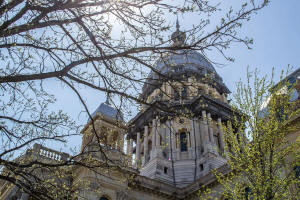As budget tightens, report finds Illinois better prepared for recession
than in recent past
 Send a link to a friend
Send a link to a friend
 [December 11, 2024]
By Ben Szalinski [December 11, 2024]
By Ben Szalinski
State lawmakers will face a projected budget deficit and slowing revenue
when they return to Springfield in January, but a new report shows
fiscal decisions made in recent years have put Illinois in a better
position to handle a recession than any time in recent decades.
No state is immune from the negative effects of an economic downturn,
but Illinois is more prepared today than it was for the Great Recession
of 2007-2009 or the COVID-19 recession of 2020, according to a new
report from the Illinois Economic Policy Institute and University of
Illinois Urbana-Champaign’s Project for Middle Class Renewal.
The report analyzed nine indicators of progress, such as fund balances
and past due bills, that would help the state weather a future economic
downturn.
“Illinois is better positioned to overcome challenges and withstand the
forces that trigger recessions than at any other point in recent
history,” ILEPI economist Frank Manzo told Capitol News Illinois.
The main reason Illinois is more prepared is because it eliminated its
backlog of unpaid bills in the years since the state’s budget impasse
ended in 2017. The backlog had reached nearly $17 billion at the height
of the two-year impasse between Republican Gov. Bruce Rauner and
Democrats in the General Assembly. But it now sits generally between a
$2 billion to $3 billion range, putting it in line with a standard
30-day billing cycle.

Illinois has enjoyed nine credit upgrades collectively from the three
major credit rating agencies since the impasse, as bills are now paid by
the comptroller when they arrive each month.
“Those higher credit ratings allow the state to borrow money at lower
interest rates, which save money for Illinois taxpayers. Lower General
Fund deficits and better credit ratings put Illinois in a much better
position to reduce the depth and severity of the next recession,” the
report stated.
A healthier reserve fund also provides the state with more money to fund
operations if revenue dips. The Budget Stabilization Fund, more commonly
known as the “rainy day” fund, had a balance of $2.2 billion as of Dec.
2. That’s a major improvement from 2007 when the fund had just $276
million available, enough to fund the state for four days, according to
the report. But researchers also said Illinois should follow a Fitch
Ratings recommendation to set aside $3 billion to $5 billion in
reserves.
Researchers also credited the state’s recent decisions to increase
annual payments into state pension funds when surpluses allowed for it.
In fiscal years 2022 and 2023, the state contributed $700 million more
in total to its pension funds than was required by law, helping to slow
the growth of unfunded liabilities.
The pension systems were collectively funded at 46% at the end of fiscal
year 2024, according to the Commission on Government Forecasting and
Accountability. That’s an improvement from 44.6% funded last year and
the highest ratio since 2021 when the state enjoyed strong investment
returns. However, unfunded pension liabilities grew by $1.5 billion in
FY24 to $143.7 billion. The liability has continued to grow after
briefly declining in 2021.
The pension payment required by law each year, meanwhile, will consume
about 19 percent of the state’s general revenue spending in FY25.
“While the condition of the state-funded retirement systems poses
challenges for the financial well-being of Illinois and hinders the
State’s ability to invest in public services and infrastructure, marked
improvements in funding, including supplementary contributions during
the Pritzker Administration, indicate that Illinois is better prepared
for a recession than it has been at any time since 2008,” the report
said.
Still, a separate report from COGFA showed Illinois lags the nation in
new job growth when compared to pre-pandemic job levels in fall 2019.
The state has recovered all the jobs lost during the pandemic, but has
only added about 29,000 jobs since October 2019, an increase of 0.5%
compared to the national rate of 4.9%, according to COGFA Chief
Economist Benjamin Varner.
[to top of second column]
|

The Illinois State Capitol building in Springfield. (Capitol News
Illinois file photo by Jerry Nowicki)

The Champaign-Urbana and Bloomington metropolitan areas are the only
ones in Illinois to surpass the national job growth rate since the
pandemic, logging growth numbers of 8.4% and 7.3% respectively,
according to COGFA. The Champaign area, with the University of Illinois’
main campus, benefited as a hub of government employment while
Bloomington has seen new manufacturing growth.
The Chicago area saw 0.3% growth and made gains in the private education
and health services sector, but lost hospitality jobs. The Kankakee
metropolitan area saw the largest decline since 2019 with total
employment down 5.2%.
Researchers with ILEPI and UIUC also noted Illinois has a new tool to
mitigate job losses when the next recession hits. Illinois implemented a
work-share program that allows employers to temporarily reduce
employees’ hours and receive partial unemployment benefits to help avoid
layoffs. It was created in 2015, but the state didn’t implement it until
2021. NPR Illinois previously reported it could have saved up to 124,000
jobs and reduced unemployment costs by $1 billion during the 2020
recession.
Replenishing the state’s unemployment insurance trust fund after the
pandemic, increasing investments in public education, passing an
infrastructure bill, climate resilience projects and embracing a
Medicaid expansion under the federal Affordable Care Act all help create
jobs and financial security for residents, which creates more stability
in the state’s economy, according to the report. Job creation
establishes a “foundation for recovery,” Manzo said.
But the report also suggested state lawmakers should review Illinois’
tax structure. Researchers wrote the state’s flat income tax structure
and local reliance on property taxes is more resilient than other tax
systems to a recession, but the lack of robust sales taxes on services
creates more vulnerability.
The report suggests a flat tax reduces volatility in a recession, UIUC
professor Robert Bruno said, but he added the report does not conclude
that it is the best overall structure for a state’s economy and budget.
“The more volatile the tax structure, the more, if you will, at risk the
state is to negative impacts of a recession,” Bruno told Capitol News
Illinois.

What matters most is how states spend tax revenue, such as if it’s
spending on critical services and infrastructure or shoring up the
“rainy day” fund and pensions, Manzo said.
Early fiscal year 2026 estimates from the governor’s office, meanwhile,
project a potential budget shortfall of $3.2 billion if the state
doesn’t decrease spending or raise revenue.
Read more: Pritzker’s budget office projects $3.2B deficit in early look
at upcoming fiscal year
Tax revenue for the state continues to lag this year, according to
COGFA’s November report. Corporate income taxes have dropped by 15.3% in
fiscal year 2025 through November compared to the first five months of
fiscal year 2024. Personal income tax receipts have risen by 6.4%, but
sales tax receipts have seen little growth and are down $8 million this
year compared to FY24. Analysts said they’re hopeful holiday shopping
will boost sales tax receipts.
The state’s revenue total so far in FY25 also remains $291 million
behind this point in FY24, mostly thanks to $633 million of one-time
federal money the state received last year but is not receiving this
year – an expected drop. State revenue is up $342 million excluding the
loss of those federal funds.
Capitol News Illinois is a nonprofit, nonpartisan news
service that distributes state government coverage to hundreds of news
outlets statewide. It is funded primarily by the Illinois Press
Foundation and the Robert R. McCormick Foundation. |